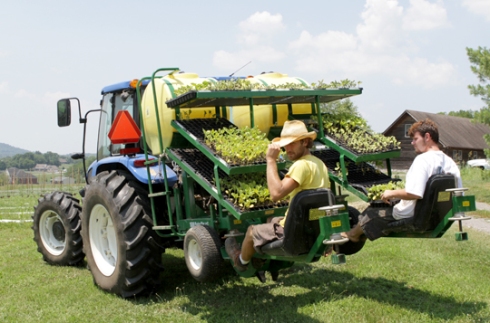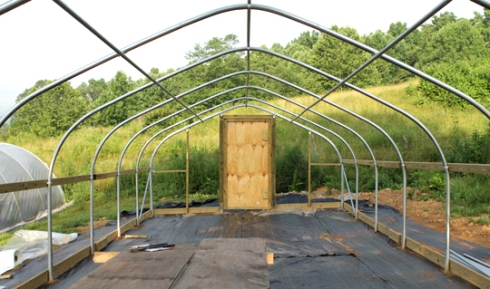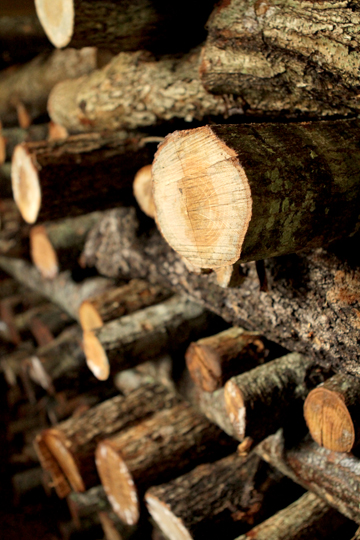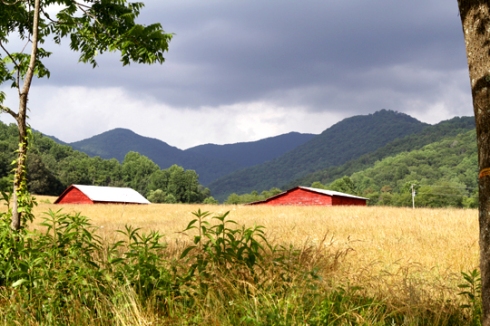The first thing I noticed upon crossing from North Carolina into Tennessee was the stifling rise in temperature. Ten days in the Smokey Mountains made me forget how far below the Mason Dixon Line we actually are. The chosen route to farm #2 wound through Smokey Mountain National Park, where a cool mist and soft breeze rendered air conditioning obsolete. However, 45 minutes later, and a few thousand feet lower, the temperature went from 80 to 100, with a heat index that easily topped 105. Welcome to the South.
By the way, my car has no AC.
With the windows down and lots of water handy, we continued on towards Nashville, speculating all the while how we would handle working in such oppressive heat. Will the next farm have AC? Maybe. Plumbing or a compost toilet? Compost, Doug guessed. Hot water? Doug guessed no, but I said yes. We made a few bets, then got lost, and finally arrived at Green Market Farm around 10 pm.
We pulled into the driveway of a stately southern mansion.
“This is their house,” Doug said, “We’re probably staying in the barn out back.”
After knocking, a young guy with boundless energy opened the door. He informed us that the farmers didn’t live here. They lived a few miles away. This was the stately southern mansion for farm volunteers. Everyone had their own space, a comfortable bed, and a hot shower. The house had internet access and a washer/dryer. A wonderful lady named Jaya prepared gorgeous vegetarian feasts daily. The AC was blasting. Somehow, we had unwittingly stepped into a wwoofer’s paradise.
There have been more lessons and a look into a different methodology with organic farming. In NC, everything was small scale and hands-on. We planted everything individually on our hands and knees. We watered with 5 gallon buckets. It worked out great, but painted a picture of organic farming that isn’t always true. Sometimes there are 5 gallon buckets and stirrup hoes. Sometimes there are power tools and a brand-new, air conditioned tractor.
One method isn’t necessarily better than the other; it is merely a question of scale. Green Market Farm is much bigger. Although they have a wide variety of in-season produce (okra, squash, green beans, and cucumbers, to name a few), tomatoes are their strongest suit. The farm boasts 8,000 tomato plants, and each plant will produce 20-25 pounds of fruit before the season is through. Green market has every kind of tomato you can imagine, in most any size, shape, and shade of the rainbow. As for space, there are 15 acres of cultivated land spread out in three different fields. With this much space and these many plants, mechanization is necessary.
Green Market has a tractor with some innovative flair: An attachment allows two people to sit on either side of an unplanted row. As the tractor rolls down the row at a slow speed, spiked wheels puncture holes into the row cover and dump water into them. Those sitting in the seats can then put the seeds or plants into the watered holes. Take a look:
It was a far cry from racing the other volunteers at Anna and Paul’s Farm down the rows as we planted on our hands and knees. However, there are good and bad sides to mostly any situation. Sure, taking a leisurely tractor ride is nice, as long as you can stand the smell. Some of the most nutrient dense, healthy-for-plants fertilizers around are fish poop and seaweed, and Green Market Farm isn’t shy about using either. They have a special blend of the two, and use it to make the soil a rich, ideal environment for growth, but it’s at the expense of the workers’ nostrils. The aroma is a cross between sweet and pungent, and a New Jersey bay in the heat of August. The volunteers had their hands swimming in the stuff all day, an experience that I’m certain toughened me up at least a little.
Green Market Farm didn’t only give me my first experience on a tractor, but also my first experience running a mean chainsaw– I didn’t want to touch the big one, so they gave me one attached to a ten foot pole. We put up a deer fence through the woods, but first we had to clear a path through the brambly Tennessee jungle.
Green Market Farm sells produce at two farmers’ markets, one of which is in Nashville. Here are a few images I took:
A final note on tomatoes here in Tennessee. Folks like to call them “maters.”
“Did you see how big that ‘mater was!? Two pounds, easy.”
“The ‘maters are lookin’ great.”
“What are we gonna do with all these ‘maters!?”
That last question is easy. Pair them with some of the delicious lemon basil that’s growing in the field and make a killer ‘mater salad.





































